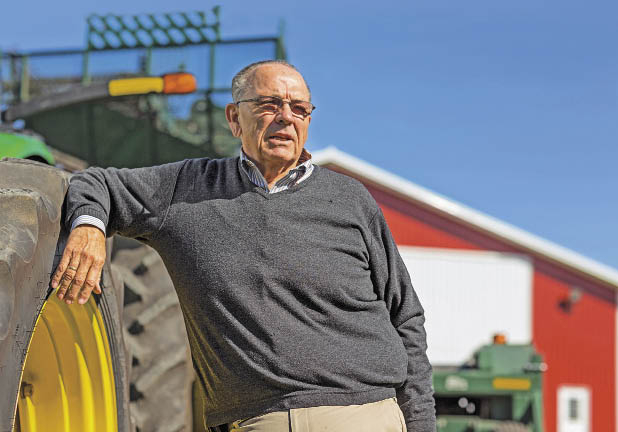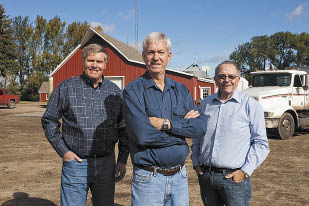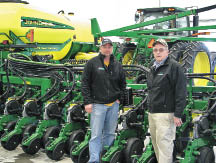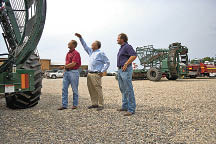
Change is a constant in agriculture, just as in any other field.
William "Buzz" Baldwin Jr. works to keep pace with it at Baldwin Farms Inc. in St. Thomas, N.D. He runs the family corporation with his wife, LeAnn, son, Brent, and daughter-in-law, Stephanie.
"Our farm has gone from one-row harvesters to 12-row harvesters, from small trucks to tri-axles," Buzz said. "It's amazing the changes I've seen in my lifetime in 48 years of growing beets.
"The last 10 years has just been rapid the way technology has changed," he said. "My son handles it with the GPS in the tractors. It's just amazing what can be done."
Buzz occupies a great vantage point for watching it unfold. His family traces its start in the sugarbeet industry back to 1926.
"My son is fourth generation," Buzz, 66, said. "My grandfather, Silas Baldwin, started with a small acreage. I started farming with my father, William Baldwin Sr., in 1964. My father passed away in 1972. When I took over we expanded the farm."
Family ties
Heritage and tradition means a great deal to the Baldwins.
"We're a hands-on family farm," Buzz said. "I enjoy getting up and getting out here every morning. That's my main job.
"My son has farmed since high school and while in college," he said. "He's virtually the right-hand of the farm. We raise sugarbeets, dry bean, wheat and soybeans. We also sublet some land for potatoes."
Brent, 42, graduated with a degree in finance from Mayville (N.D.) State University in 1993. Buzz and LeAnn also have three daughters, Laurie, Sadie and Mary Beth. Laurie Sieben and her husband, Brian, have two daughters, Cassie and Carlee. Sadie Woinarowicz has three children, Isabelle, Chloe and Chase. Mary Beth Krogstad and her husband, Scott, have one son, Jack.
Brent and Stephanie have one daughter, Samantha, 22, and two sons, Hunter, 16, and Braylon, 7. Samantha graduated last year from Bemidji (Minn.) State University with a degree in business management.
Skirting the drought
Sugarbeets are the main crop at Baldwin Farms with an average of 1,850 acres planted, followed by wheat (1,500), dry edible pinto beans (1,450) and soybean seed (500).
"Last year we had an extremely large beet crop, right around 29-ton average, for a very good year," Buzz said. "Our five-year average is around 24."
Sugar content hit 19 percent, he added. The five-year average is 18 percent.
"We had some piling issues with frost, rain and snow," he said. "Our harvest got dragged way out."
But the drought that plagued much of the nation did not impact this area of North Dakota.
"We were kind of on the northern edge of the drought," Buzz said. "We didn't have an oversupply of moisture. I guess you couldn't have ordered it better.
"We had an early spring," he added. "We went into a dry spell probably about the right time for our beets to go down. And we had high quality and got some rain in August. The cards were right last year with the weather and moisture. It was a spectacular year for sugarbeets."
Yet no two growing seasons are the same.
"This year we had more than an average amount of snow," Buzz said. "So it looks like it'll be a later spring."
Beet planting got under way in late April. Pre-harvest will take place around the last week of August and first week of September.
"Oct. 1 is usually the day we start harvesting 24 hours, providing weather is good," Buzz said. The trip to the piling stations is between 5 to 10 miles.
"We try to do it in two weeks," he said. "Sometimes it stretches out to three weeks. Last year we were digging out until the middle of November."
The beet factory is located in Drayton, N.D., about 15 miles west of St. Thomas, which had a population of 331 at the 2010 census. Drayton's population is less than 1,000.
Challenges
"Our biggest challenge is weed control," said Buzz. "Roundup Ready really helped. But there's a concern the more of it you use, weeds become immune to it, and you lose control of it."
Other resistant weeds in the area are ragweed, waterhemp and horseweed/marestail.
The Baldwins started using Roundup Ready beets three years ago.
"We used it 100 percent the first year," Buzz said. "Other people around here just went half, two-thirds, but now it's virtually 98 percent Roundup."
"Our biggest problem was kochia," Buzz said. "Roundup Ready is working very well for us so far. And it's helping out other crops too."
Baldwin Farms tries to use a four-year rotation, but sometimes it's three.
"Beets one year, then dry edible beans to wheat, and then maybe back to potatoes," Buzz said. "We rotate in between the beet crops."
American Crystal

"I'm very proud of the American Crystal Sugar Company," Buzz said. "It's a very successful, well-respected cooperative sugar company."
Buzz is currently a director at American Crystal, representing the Drayton factory district. Other factory districts are in East Grand Forks, Crookston and Moorhead, all in Minnesota, and Hillsboro, N.D.
On April 10, 1972, 1,500 growers met in Grand Forks to decide whether the Red River Valley Sugarbeet Growers Association should buy American Crystal. The measure passed with 70 percent voting in approval.
On Feb. 15, 1973, Crystal Growers Corporation, formed as a vehicle for the merger, approved the $86 million purchase at $104 per share. The resulting purchase united the company and the association.
"Our sugar industry was deteriorating at that time," Buzz said. "The growers led by Al Bloomquist, executive secretary of the Red River Valley Growers Association, made an offer to American Crystal and purchased it. A lot of people were very nervous and leery. We got the backing of the bank of co-ops.
"And we've done very well," he said. "That's not to say we haven't had our challenges and always will. But we're very proud of the company. I'm very proud to be a member of the board. It's an honor."
Buzz became director of the Drayton Factory District in 1986. He became a member of the Red River SGA in 1988 and served as president from 1988-92. He also served on the executive committee of the American Sugarbeet Growers Association during that time. In 2004, he became a director at American Crystal.
"You represent your district, but you have to look at the company as a whole," Buzz said of his duties. "The board is very versatile and very good at looking at what's best for the growers and for the company. The growers are the company."
American Crystal now consists of 500,000 shares, which are owned and operated by the growers. Presently, 82 to 87 percent of available acreage is planted annually to meet the processing capacity. The amount of beets grown per acre keeps going up.
"Genetics have been able to outgrow the factories," Buzz said. It's one more change for which the industry must adapt.
"I'm very positive about the sugar industry," Buzz said. "Sugar growers nationwide are survivors. They are the most optimistic people in the world."


